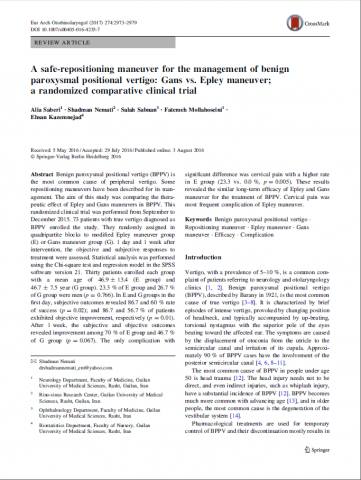Manevr Epli Video

Feb 1, 2016 - Use this video to guide you through the epley maneuver at home! This is a great technique to use for benign paroxysmal positional vertigo. How do I get ready for the home Epley maneuver? You can do the home Epley maneuver on a bed. You start by sitting on the bed. You need to have a pillow in place so that when you lie back it will be under your shoulders. What happens during the home Epley maneuver? You may find it helpful to watch a video of the home Epley maneuver first.
You may contact a local store to check availability of an item.
The Epley maneuver or repositioning maneuver is a maneuver used by medical professionals to treat one common cause of, (BPPV) [ ] of the posterior or anterior canals of the ear. It works by allowing free-floating particles from the affected to be relocated, using gravity, back into the, where they can no longer stimulate the, therefore relieving the patient of bothersome vertigo. This maneuver was developed by Dr. John Epley and first described in 1980. A version of the maneuver called the 'modified' Epley does not include vibrations of the mastoid process originally indicated by Epley, as they have since been shown not to improve the efficacy of the treatment. Contents • • • • • • • Effectiveness [ ] The Epley maneuver is a safe and effective treatment for BPPV, though the condition recurrs in around one third of cases.
Sequence of positions [ ] The following sequence of positions describes the Epley maneuver: • The patient begins in an upright sitting posture, with the legs fully extended and the head rotated 45 degrees towards the side in the same direction that gives a positive. • The patient is then quickly lowered into a supine position with the head held approximately in a 30-degree neck extension ( position), with the head still rotated to the side. • The clinician observes the patient's eyes for “primary stage”. • The patient remains in this position for approximately 1–2 minutes. • The patient's head is then rotated 90 degrees in the opposite direction so that the opposite ear faces the floor while maintaining 30 degrees of neck extension. • The patient remains in this position for approximately 1–2 minutes.

• Keeping the head and neck in a fixed position relative to the body, the individual rolls onto their shoulder, rotating the head another 90 degrees in the direction that they are facing. The patient is now looking downwards at a 45-degree angle. • The eyes should be immediately observed by the clinician for “secondary stage” nystagmus (this secondary stage nystagmus should be in the same direction as the primary stage nystagmus). The patient remains in this position for approximately 1–2 minutes.
• Finally, the patient is slowly brought up to an upright sitting posture, while maintaining the 45-degree rotation of the head. • The patient holds a sitting position for up to 30 seconds. The entire procedure may be repeated two more times, for a total of three times.
During every step of this procedure, the patient may experience some dizziness. Post-treatment phase [ ] Following the treatment, the clinician may provide the patient with a soft collar, often worn for the remainder of the day, as a cue to avoid any head positions that may once again displace the. The patient may be instructed to be cautious of bending over, lying backwards moving the head up and down, or tilting the head to either side. Patients should sleep semi-recumbent for the next two nights. This means sleeping with the head halfway between being flat and upright (at a 45-degree angle). This is most easily done by using a recliner chair or by using pillows arranged on a couch. The soft collar is removed occasionally.